|

Batfish - Humpheaded batfish inhabit the
limestone outcrops, feeding on the small invertebrates. (Platax
batavianus)
|
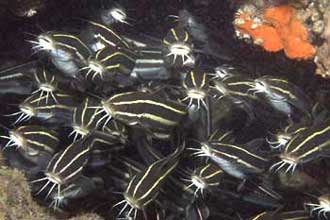
Catfish - Juvenile striped catfish form tightly
packed aggregations containing up to several hundred fish.
(Plotosus lineatus)
|
|

Cuttle Fish - Cuttlefish are a common feature
of the gulf seacape, changing colour to camouflage themselves
against the sponges and coral. (sepia)
|

Moray Eel - Moray eels peer out from cracks
and crevices in limestone outcrops, opening and closing their
mouths to pass oxygen over their gills.(Muraenidae)
|
|
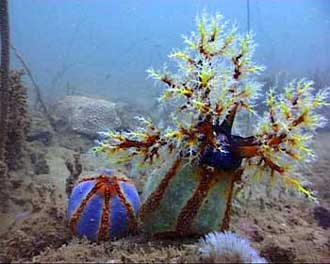
Sea Apple - An echinoderm related to seastars,
sea apples wave their tentacles about in the water capturing
plankton on which to feed.(Pseudocolochirus axiologus)
|
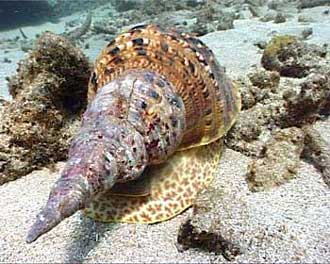
Triton - Safe from collectors in the deeper
waters of the gulf, the giant triton shell heaves itself along
on it's single foot looking for other molluscs on which to
feed. It is also one of few predators of the crown of thorn
starfish which also inhabits the gulf and can wreak havoc
if allowed to overpopulate.(Charonia tritonis)
|
|
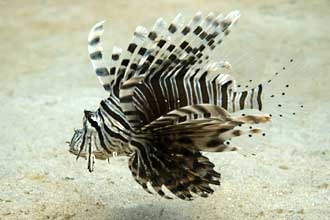
Lionfish/ Firefish - Lionfish and firefish
are common in Exmouth gulf, often inhabiting the same coral
bommies all their lives . They are often found living in family
groups, which remain together for years.
|

Fan worm - These segmented worms attach themselves
to the reef and sway in the currents using their tentacles
to capture plankton on which to feed. (Sabellidae)
|
|
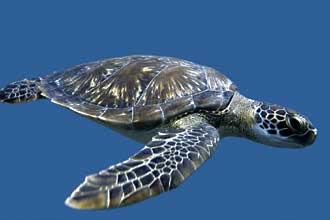
Green Sea Turtle - These turtles are amongst
the three species of turtles that nest in the Ningaloo Region
and are recognised globally as a threatened species (Chelonia
mydas)
|
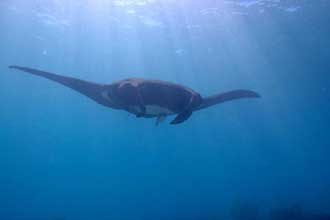
Manta Ray - The eastern waters of the Exmouth
Gulf are favoured feeding grounds of Manta Rays who follow
the tide lines feeding on the plankton and small invertebrates.
(Manta birostris)
|
| 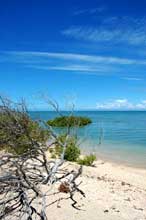
Mangroves - The eastern coast of Exmouth
Gulf supports one of the largest mangrove areas in the region.
These are a significant source of nutrients that contribute
to the valuable prawn fishery in Exmouth Gulf, and provide
a nursery area for juvenile prawns and other commercial and
non-commercial species.
|
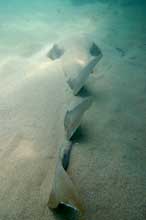
Shovel Ray - Giant shovel rays can grow up
to 2m in length. Their mouths are located on their undersides
so they can forage for invertebrates amongst the sand, while
their eyes on top can keep watch for danger! (Rhinobatos
typus).
|

Christmas tree worms -This worm builds a
tube on the surface of the coral, and as the coral grows it
buries the tube in the skeleton of the coral. Then the worm
is protected with only its head showing. If danger threatens,
the worm can pull its head down into its tube in the blink
of an eye.(Spirobranchus giganteus)
|
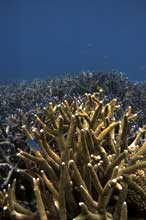 Coral - Many species of coral live in the
nutrient rich waters of the Exmouth Gulf. These staghorn corals
grow relatively fast, stretching towards the sunlight, which
they require for photosythesis. (Acropora cervicornis)
Coral - Many species of coral live in the
nutrient rich waters of the Exmouth Gulf. These staghorn corals
grow relatively fast, stretching towards the sunlight, which
they require for photosythesis. (Acropora cervicornis)
|


![]()

![]()

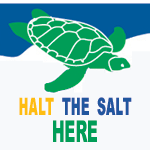

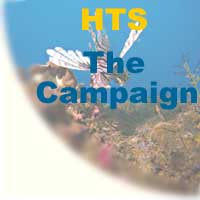













 Coral - Many species of coral live in the
nutrient rich waters of the Exmouth Gulf. These staghorn corals
grow relatively fast, stretching towards the sunlight, which
they require for photosythesis. (Acropora cervicornis)
Coral - Many species of coral live in the
nutrient rich waters of the Exmouth Gulf. These staghorn corals
grow relatively fast, stretching towards the sunlight, which
they require for photosythesis. (Acropora cervicornis)